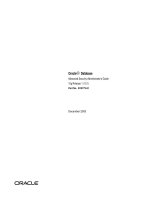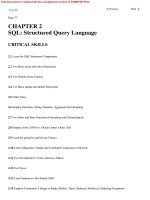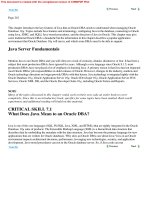Oracle Database 10g A Beginner''''s Guide phần 2 potx
Bạn đang xem bản rút gọn của tài liệu. Xem và tải ngay bản đầy đủ của tài liệu tại đây (1.4 MB, 23 trang )
Team Fly
Page 33
CHAPTER 2
SQL: Structured Query Language
CRITICAL SKILLS
2.1 Learn the SQL Statement Components
2.2 Use Basic insert and select Statements
2.3 Use Simple where Clauses
2.4 Use Basic update and delete Statements
2.5 Order Data
2.6 Employ Functions: String, Numeric, Aggregate (No Grouping)
2.7 Use Dates and Data Functions (Formatting and Chronological)
2.8 Employ Joins (ANSI vs. Oracle): Inner, Outer, Self
2.9 Learn the group by and having Clauses
2.10 Learn Subqueries: Simple and Correlated Comparison with Joins
2.11 Use Set Operators: Union, Intersect, Minus
2.12 Use Views
2.13 Learn Sequences: Just Simple Stuff
2.14 Employ Constraints: Linkage to Entity Models, Types, Deferred, Enforced, Gathering Exceptions
This document is created with the unregistered version of CHM2PDF Pilot
2.15 Format Your Output with SQL*Plus
Team Fly
This document is created with the unregistered version of CHM2PDF Pilot
Team Fly
Page 34
SQL is the fundamental access tool of the Oracle database; in fact, it is the fundamental access tool of all relational
databases. SQL is used to build database objects and it is also used to query and manipulate both these objects and
the data they may contain. You cannot insert a row of data into an Oracle database unless you have first issued some
basic SQL statements to create the underlying tables. While Oracle provides SQL*Plus, a SQL tool that enables you
to interact with the database, there are also many GUI tools that can be used, which then issue SQL statements on
your behalf behind the scenes.
CRITICAL SKILL 2.1
Learn the SQL Statement Components
Before learning many of the SQL commands that you will use frequently, first let's take a look at the two different
categories into which SQL statements are classified. They are DDL, or data definition language, and DML, or
data manipulation language. The majority of this chapter will deal with the latter.
DDL
DDL is the set of SQL statements that define or delete database objects such as tables or views. For the purposes of
this chapter, we will concentrate on dealing with tables. Examples of DDL are any SQL statements that begin with
create, alter, drop, and grant. Table 2-1 is a sample list of some DDL statements. It does not completely represent
the many varied statements that all have a unique purpose and value.
SQL Command Purpose
create table Creates a table
create index Creates an index
alter table Adds a column, redefines an existing column,
changes storage allocation
drop table Drops a table
grant Grants privileges or roles to a user or
another role
truncate Removes all rows from a table
revoke Removes privileges from a user or a role
analyze Gathers performance statistics on database
objects for use by the cost-based optimizer
TABLE 2-1. Common Formats of Date Type Data
This document is created with the unregistered version of CHM2PDF Pilot
Team Fly
This document is created with the unregistered version of CHM2PDF Pilot
Team Fly
Page 36
All DML commands require reference to an object that will be manipulated. More often than not, the object being
referenced is a table.
A conditional statement can be added to any select, update, or delete command. Absence of a conditional
statement means that the command will be performed against every record in the object. A conditional statement is
used when the DML command is intended to only act upon a group of records that meet a specific condition. The
where clause will be discussed a little later in this chapter.
More optional DML statements will be described later in this chapter. For now, let's concentrate on understanding
the fundamental structure of each DML statement starting with the insert and select statements.
CRITICAL SKILL 2.2
Use Basic insert and select Statements
Getting data into and out of a database are two of the most important features of a database. Oracle provides two
basic features that help you do just that. To get data into the database, use the insert command; to get it back out,
use the select command. You must master these commands, as they form the basic of most data access to your
Oracle database. This section talks first about how to get data into your database, and then how to get data out.
insert
Using the state table created in the DDL example, the following is an illustration of using the insert statement in its
simplest form:
This document is created with the unregistered version of CHM2PDF Pilot
Team Fly
Page 39
CRITICAL SKILL 2.3
Use Simple where Clauses
Up to now, you have seen how the select command can be used to retrieve records from a table. However, our
basic examples have all retrieved every record from the table. If you want to see only certain rows, you must add a
where clause.
Since our previous examples returned every record in the table, we created a simple table with a few rows in it for
illustration purposes. Had we chosen to illustrate the select command against the large sample tables provided by
Oracle, we would have returned thousands of rows far too many for listing in this chapter. Now that we are
introducing the where clause, we will be able to control the output. As a result, the remaining examples in this chapter
will now use the customers, products, sales, and costs tables that are part of the Oracle sample database. Let's
describe each of these tables.
This document is created with the unregistered version of CHM2PDF Pilot
Team Fly
Page 46
between A and B Greater than or equal to
A and less than or equal
to B.
select * from sales
where amount_sold is
between 100 and 500;
not between A and B Not greater than or
equal to A, and not less
than or equal to B.
select * from sales
where amount_sold is
not between 100 and
500;
like '%tin%' Contains given text (for
example, 'tin').
select * from customer
where cust_last_name is
like '%tin%';
TABLE 2-2. Common Comparison Operators
CRITICAL SKILL 2.4
Use Basic update and delete Statements
While select will likely be the command you use the most; you'll use the update and delete commands regularly,
too. As you will in Chapter 6, your programs will have a mixture of DML statements. In this section, we'll take a
closer look at the update and delete commands.
update
It is often necessary to change data stored within a table. This is done using the update command. There are three
parts to this command:
1. The word update followed by the table to which you want to apply the change. This part is mandatory.
2. The word set followed by one or more columns in which you want to change the values. This part is also
mandatory.
3. A where clause followed by selection criteria. This is optional.
Let's imagine that one of our customers has requested an increase in their credit limit and our accounting department
has approved it. An update statement will have to be executed to alter the credit limit. For illustration purposes, a
customer record will be displayed before and after the update. The following example illustrates a simple update for
one customer:
This document is created with the unregistered version of CHM2PDF Pilot
Team Fly
Page 50
CRITICAL SKILL 2.5
Order Data
So far, all of our select queries have returned records in random order. Earlier, we selected records from the
customer table where the customer was located in either Connecticut or Utah and had a credit limit of $15,000. The
results came back in no apparent order. It is often desirable to order the result set on one or more of the selected
columns. In this case, it probably would have been easier to interpret the results if they were sorted by state, and
within that state were then sorted by customer ID. Let's take a look at the query syntax and resulting output:
This document is created with the unregistered version of CHM2PDF Pilot
Team Fly
Page 51
This document is created with the unregistered version of CHM2PDF Pilot
Team Fly
Page 54
CRITICAL SKILL 2.7
Use Dates and Data Functions (Formatting and Chronological)
Date is the next commonest type of data you'll find in an Oracle database after character and numeric data. The date
data type consists of two principal elements: date and time. It's important to keep in mind that the date data type
includes time when comparing two dates with each other for equality.
The default date format in many Oracle databases is DD-MON-YY, where DD represents the day, MON is the
month and YY is the two-digit year. A date can be inserted into a table without specifying either the four-digit year or
a value for the time element. Oracle will default the century to '20' for years '00 49' and '19' for years '50 99'.
Without a specific time being specified during an insert, the time will default to midnight, which is represented as
'00:00:00'.
Date Functions
As with the numeric and character data types, Oracle has provided many date functions to help with the manipulation
of date data. If you were to routinely print customized letters to your best customers offering them a special deal that
expires on the last day of the month, the last_day function could be used to automatically generate the expiration date
for the offer. Table 2-6 shows the commonest date functions.
Function Action Example Displays
Sysdate Returns current
system date. Time
could also be
retrieved using the
to_char function,
which is discussed
in the next section.
select sysdate
from dual;
17-MAR-04
on March 17,
2004
last_day(date) Returns last day of
the month for date.
select
last_day('17-MAR-04'
) from dual;
31-MAR-04
Team Fly
This document is created with the unregistered version of CHM2PDF Pilot
Team Fly
Page 57
CRITICAL SKILL 2.8
Employ Joins (ANSI vs. Oracle): Inner, Outer, Self
Up until now, all of the examples in this chapter have selected data from only one table. In actual fact, much of the
data that we need is in two or more tables. The true power of a relational database (and the source of its name)
comes from the ability to relate different tables and their data together. Understanding this concept is critical to
harvesting the information held within the database. This is more commonly known as joining two or more tables.
With Oracle Database 10g, queries can be written using either Oracle's SQL syntax or ANSI syntax. While Oracle
hasn't made ANSI syntax available until recently, it has been used in non-Oracle environments for some time. Many
third-party tools accept ANSI SQL and, as you'll see shortly, the joins are quite different.
Inner Joins
An inner join, also known simply as join, occurs when records are selected from two tables and the values in one
column from the first table are also found in a similar column in the second table. In effect, two or more tables are
joined together based on common fields. These common fields are known as keys. There are two types of keys:
A primary key is what makes a row of data unique within a table. In the CUSTOMERS table, CUST_ID is the
primary key.
A foreign key is the primary key of one table that is stored inside another table. The foreign key connects the two
tables together. The SALES table also contains CUST_ID, which in the case of the SALES table, is a foreign key
back to the CUSTOMERS table.
Oracle Inner Joins
The tables to be joined are listed in the from clause and then related together in the where clause. Whenever two or
more tables are found in the from clause, a join happens. Additional conditions can still be specified in the where
clause to limit which rows will be returned by the join. For example, when we queried the SALES table on its own,
the only customer information available to us was the CUST_ID. However, if we join each record, we retrieve from
the SALES table by the CUST_ID to the same column in the CUSTOMERS table, and all the customer information
becomes available to us instantly.
Team Fly
This document is created with the unregistered version of CHM2PDF Pilot
Team Fly
Page 62
This document is created with the unregistered version of CHM2PDF Pilot
Team Fly
Page 65
Any of the combinations will produce exactly the same results. Let's hold off on the left outer join example until we
revisit the outer join idea later in Project 2-4.
ANSI Full Outer Joins A full outer join is possible when using the ANSI syntax without having to write too much
code. With a full outer join, you will be able to return both the right outer join and left outer join results from the
same query.
The full outer join queries can be written as full outer join or full join and once again, the on, using, or natural
joins are all possible. Let's revisit the Outer Joins Project and try the ANSI syntax out.
Project 2-2 Joining Data Using ANSI SQL Joins
Using the temp1 and temp2 tables we created and populated, let's try out the ANSI right, left, and full outer joins.
Step by Step
We've just learned that you can write the ANSI outer joins with or without the outer keyword in each of the ANSI
right, left, and full outer joins. We also learned that the ANSI on, using, and natural join syntax is available as
well. The following step-by-step instructions use a combination of these for illustration purposes. Feel free to try
alternate syntax, but we encourage you to adopt a consistent style to allow your code to be self-documenting and
traceable by other developers.
1. Use the ANSI right outer join:
This document is created with the unregistered version of CHM2PDF Pilot
Team Fly
Page 67
This document is created with the unregistered version of CHM2PDF Pilot
Team Fly
Page 69
Project 2-3 Grouping Data in Your select Statements
One final example will demonstrate the grouping of multiple columns and more than one function being performed for
each group. As we build on this example, we will introduce column aliases, a round function combined with an avg
function and the use of a substr function, which will serve to select only a specified number of characters for the
product subcategories and names results.
Step by Step
Let's start with the preceding group by example and build on it as we introduce some formatting and intermediate
concepts. Look at the output each time and see how we are transforming it along the way. A final output listing has
been provided at the end for you to compare against.
1. Start SQL*Plus and re-execute the preceding group by example:
This document is created with the unregistered version of CHM2PDF Pilot
Team Fly
Page 72
CRITICAL SKILL 2.10
Learn Subqueries: Simple and Correlated Comparison with Joins
Within SQL, functionality exists to create subqueries, which are essentially queries within queries. This power
capability makes it possible to produce results based on another result or set of results. Let's explore this concept a
little further.
Simple Subquery
Without the functionality of subqueries, it would take a couple SQL queries to retrieve product information for the
product with the maximum list price. The first query would have to find the value of max(prod_list_price). A
subsequent query would have to use the value resolved for max(prod_list_price) to find the product details. Let's
take a look at how we can resolve this with a subquery embedded in the where clause of the main query:
This document is created with the unregistered version of CHM2PDF Pilot
Team Fly
Page 74
CRITICAL SKILL 2.11
Use Set Operators: Union, Intersect, Minus
One of the nice things about a relational database is that SQL queries act upon sets of data versus a single row of
data. Oracle provides us with a series of set functions that can be used to join sets together, for example. The set
functions will be discussed in the next few sections using two single column tables: table x and table y. Before
proceeding to the discussion on the set functions, let's first take a look at the contents of these tables.
Table x:
This document is created with the unregistered version of CHM2PDF Pilot
Team Fly
Page 76
NOTE
Please be aware that the intersect set operator can introduce major performance problems. If you are
venturing down this path, weigh the alternatives first.
minus
The minus set function returns all the rows in the first table minus the rows in the first table that are also in the second
table. The order of the tables is important. Pay close attention to the order of the tables and the different results in
these two query examples:
This document is created with the unregistered version of CHM2PDF Pilot
Team Fly
Page 78
CRITICAL SKILL 2.12
Use Views
Views are database objects that are based on one or more tables. They allow the user to create a pseudo-table that
has no data. The view consists solely of an SQL query that retrieves specific columns and rows. The data that is
retrieved by a view is presented like a table.
Views can provide a level of security, making only certain rows and columns from one or more tables available to the
end user. We could hide the underlying tables, CUSTOMERS and SALES from all the users in our organization and
only make available the data for states they are entitled to see. In the following example, we are creating a view to
only show specific details about Utah-based customers sales:
This document is created with the unregistered version of CHM2PDF Pilot
Team Fly
Page 79
rows and columns from this view. The second example selects only the name and total columns for customers whose
sales are greater than 20,000. Keep in mind, this is still only for Utah customers.
This document is created with the unregistered version of CHM2PDF Pilot
Team Fly
Page 80
Sequences are objects in the database that can be used to provide sequentially generated integers. Without these
valuable objects available to users, generating values sequentially would only be possible through the use of programs.
Sequences are generally created and named by a DBA. Among the attributes that can be defined when creating a
sequence are a minimum value, a maximum value, a number to increment by and a number to start with. They are
then made available to the systems applications and users that would need to generate them.
For the following example, we have established a cust_id_seq sequence, which increments by one each time it's
called. When we created the sequence, we specified that 104501 should be the number to start with. For
demonstration purposes, we'll use the DUAL table to select the next two sequence numbers. More often than not, an
application will retrieve and assign the sequence numbers as records are inserted into the associated table.
This document is created with the unregistered version of CHM2PDF Pilot
Team Fly
Page 83
Ask the Expert
Q: Is a single space an acceptable entry into a NOT NULL constrained column?
A: Yes. Oracle will allow you to enter a space as the sole character in a NOT NULL constrained
column. Be careful though. The single space will look like a NULL value when a select statement
retrieves and displays this row. The space is very different than a NULL.
Deferred
When constraints are created, they can be created either as deferrable or not deferrable. A constraint that is not
deferred is checked immediately upon execution of each statement and if the constraint is violated, it is immediately
rolled back. A constraint that is deferred will not be checked until a commit statement is issued. This is useful when
inserting rows or updating values that reference other values that do not exist but are part of the overall batch of
statements. By deferring the constraint checking until the commit is issued, we can complete the entire batch of
entries before determining if there are any constraint violations.
CRITICAL SKILL 2.15
Format Your Output with SQL*Plus
Throughout this chapter, we've seen the results of many SQL queries. In some, we added functions like substr to
reduce the size of the columns and keep the results confined within one line. In SQL*Plus, there are many parameters
that can be set to control how the output is displayed. A list of all of the available settings is easily obtained by issuing
the show all command within SQL*Plus. Alternatively, if you know the parameter and want to see its current value,
the command show parameter_name will give you the answer. Before we close out this chapter, let's visit a number
of the more useful SQL*Plus parameters.
Page and Line Size
The set linesize command tells Oracle how wide the line output is before wrapping the results to the next line. To set
the line size to 100, enter the command set linesize 100. There is no semicolon required to end set commands.
Team Fly
This document is created with the unregistered version of CHM2PDF Pilot
Team Fly
Page 84
Ask the Expert
Q: Once I set parameters, do I ever have to set them again?
A: Yes. Parameters are good only for the current setting. The parameters always reset to their
default settings when you start up a new SQL*Plus session. However, the parameter defaults can
be overwritten at the start of each SQL*Plus session by entering and saving them in the login.sql
file.
The set pagesize command determines the length of the page. The default page size is 14 lines. If you don't want to
repeat the result headings every 14 lines, use this command. If you want your page to be 50 lines long, issue the
command set pagesize 50.
Page Titles
The ttitle command includes a number of options. The default settings return the date and page number on every
page followed by the title text centered on the next line. Multiple headings can also be produced by separating the
text with the vertical bar character. The command ttitle 'Customer List Utah' centers the text ''Customer List" on
the first line followed by "Utah" on the second line.
Page Footers
The btitle command will center text at the bottom of the page. The command btitle 'sample.sql' places the text
"sample.sql" at the bottom center of the output listing. The command btitle left 'sample.sql' results in the footer text
"sample.sql" being placed at the left edge of the footer.
Formatting Columns
Quite often, you'll need to format the actual column data. The column command is used to accomplish this. Suppose
we are going to select the last name from the CUSTOMERS table along with a number of other columns. We know
that, by default, the last name data will take up more space than it needs. The command column cust_last_name
format a12 wrap heading 'Last Name' tells SQL*Plus that there should be only 12 characters of the last name
displayed and that the column title 'Last Name' should be displayed on two separate lines.
Project 2-5 Formatting Your SQL Output
Let's put these SQL*Plus concepts together and format the output of a SQL query. The following step-by-step
instructions will lead you through a few of these basic formatting commands.
Team Fly
This document is created with the unregistered version of CHM2PDF Pilot









